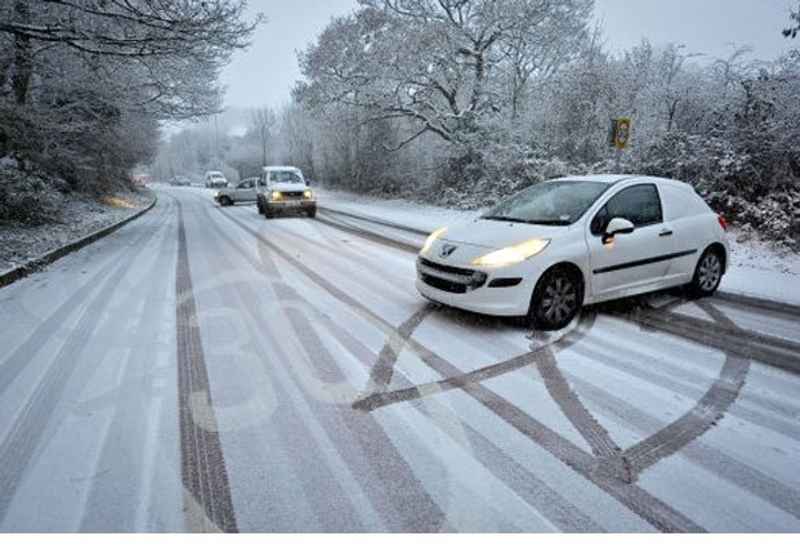Driving on snow can be quite intimidating. The thought of having no control over the steering and simply sliding off the road sends shivers down our spines. For those of you who don't know what we're talking about, here's a video of cars driving, or rather, 'trying' to drive on snow:
This video begs the question: is there any way that you can actually be completely safe and in control on snow? Well, turns out you actually can. Here are a few tried and tested ways that'll help you overcome snow-covered terrains with ease :
Use Your sixth sense to read the terrain and stay sharp

A lot of times, accidents are a result of our own carelessness and ignorance. Something we could have completely avoided if we were just a tad bit more alert of what's in front of us.
Reading the terrain correctly can sometimes be the difference between traction and no traction. Certain places on the road, like those that are shaded by trees or other structures, can potentially have ice or may still be slippery. It is important that you recognize such places and slow down even if every other part of the road is completely dry.
NOTE: Be careful about black ice while driving. Black ice is a thin layer of transparent ice that glazes over roads during winters. Once you lose traction on black ice, your car will keep sliding till the patch of ice finishes, so make sure you keep an eye out for these. If you ever encounter black ice on your path, stop, turn around and find a different route to your destination.
Alter your driving style to be safe

One simple rule about traction that can save your life - don't overdo it. You see when you drive a vehicle, the three phenomenon that you use the most are acceleration, braking and steering. Each of these phenomenon takes a toll on the traction and stresses your tyres. For your tyres to be able to maintain this traction, it is important that you don't overdo it. Every time you accelerate and turn ,or brake and turn together, you're putting multiple kinds of stresses on the tyre and asking it to do double the work. Doing this where traction is already limited is extremely risky.
To maximize the results from each phenomenon, use only one of them at a time. So let's say you have to make a turn in snow, this is how you should do it :
- Step 1: brake in a straight line.
- Step 2: steer the car to make the turn
- Step 3: straighten the wheel
- Step 4: then accelerate to go straight.
Give Calm And Composed Inputs
Always give calm and composed inputs. Do not be rough and sudden with the acceleration, brake or steering. When traction and your ability to control the car is limited, making one wrong move can make the car spiral out of control. So make sure that you give one input at a time, keep your cool and drive steadily.
Learn to adjust to the Stability and Traction Control Systems

A vehicles electronic stability control system (ESC) is basically a path control system that ensures that your car does not violently change directions. The system tries to retain the same path for the car by calculating the path the driver wishes to be on.
An ESC basically uses a steering angle sensor, a yaw sensor, a lateral G sensor and the ABS wheel speed sensors. The system takes the information from these sensors and decides how and when it should intervene.
So let's say that your vehicle starts to slide, don't go crazy and start steering violently in the opposite direction. Sudden and violent manoeuvres like that will only confuse the ESC which will then judge the inputs as accidental or forced and it will try to maintain the same path. The best thing to do in such situations would be to gradually and calmly steer in the opposite direction so that the ESC is able to understand your inputs correctly.
Its the same for traction control too. If you push the pedal all the way, chances are that the electronics are going to intervene and you won't be able to get enough power to the wheels. Again, try to gradually increase pressure on the pedal and slowly turn it up a notch.
You can also completely switch off the traction control and the ESC if you wish to avoid any electronic interventions while you drive on snow. The decision should be made depending on how well the electronic systems work to improve your drivability on snow. If you feel you're better off without them, you can switch them off for the better.
Also Read: Driving With Snow Chains : Everything You Need To Know
Use the Snow mode if you have one
Many modern vehicles now come with a snow mode in case you ever need an extra bit of inbuilt intelligence to make things easier for you. The mode alters the throttle mapping, all-wheel drive system, traction control system, ABS system, stability control system and more to make the response to various inputs more suitable for low grip surfaces. Using the vehicle's "snow" mode simply makes the driving experience more seamless because the systems know you are on a low-grip surface and are able to correct your inputs extremely quickly.
Get a set of Winter tyres
The one thing that could exponentially improve your driving on snow would be a set of winter tyres. These tyres are honestly the most underrated solutions to improve traction on snow that are simply ignored because of their potential cost of procurement. The traction you get from these tyres is extremely good and they are tailor-made for winter conditions. The best part about these tyres is that they provide all round grip to you i.e. they will not just get you out of snow but also help you stop safely. The electronics too respond relatively much better to winter tyres.
Lower the tyre pressure to increase surface contact.
Another very important trick that you should keep in mind. Lower tyre pressure will make your tyres less rounded and more flat at the point of contact. This flatness will essentially increase the contact patch of the tyre, helping you get more traction due to the increased surface area.
Don't delay the snow chains
People simply don't put their chains on until its way too late or the car is already stuck somewhere. If you can see a layer of ice/snow on the road and the tarmac is not clearly visible, you must put your chains on. They dig into the ice and snow in a way that the tread of a tyre can't. They are very effective in packed snow, which will even good snow tyres a run for their money.
Important lifesavers to keep in mind
- Always carry a shovel in your car while driving in snow. If by any chance your car does get stuck, you can easily dig the snow in front of the tyres to create room for your vehicle to move forward.
- If possible, make sure to check the road before you leave or keep an eye out even while you're driving. If there are any indications that the road might be closed or cars are slipping and getting stuck, avoid going the same way.
- Many people don't know about this but sand can be great way to increase traction in snow. If you're stuck somewhere, remember you can always find some sand around you and use it to get more traction to move. Simply put some sand in front of your drive wheels if you're stuck and you should get much better traction when you try to move your vehicle again.
Image Credits : lohud, stephaniearnold, 2ndchanceautoinsurance, mycardoeswhat, elginvw, hommeles, theunion



